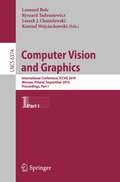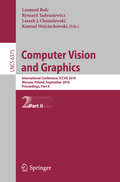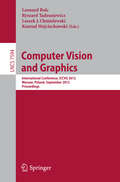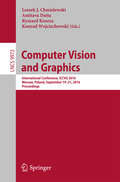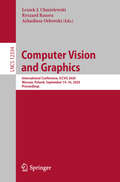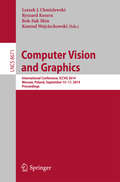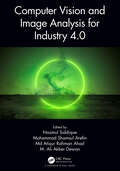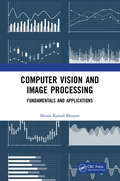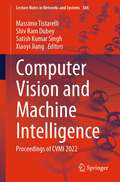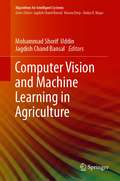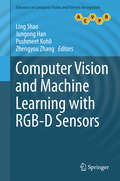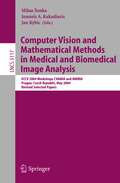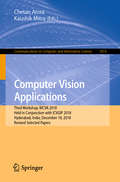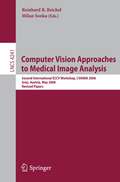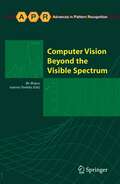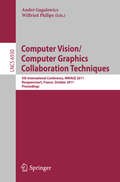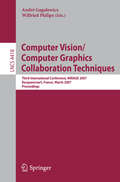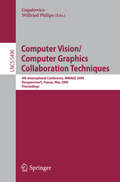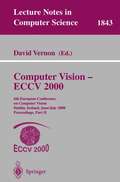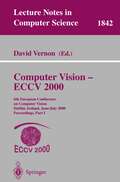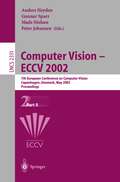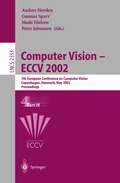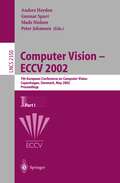- Table View
- List View
Computer Vision and Graphics: Second International Conference, ICCVG 2010, Warsaw, Poland, September 20-22, 2010, Proceedings, Part I (Lecture Notes in Computer Science #6374)
by Leonard Bolc Ryszard Tadeusiewicz Leszek J. Chmielewski Konrad WojciechowskiComputer Vision and Graphics: Second International Conference, ICCVG 2010, Warsaw, Poland, September 20-22, 2010, Proceedings, Part II (Lecture Notes in Computer Science #6375)
by Leonard Bolc Ryszard Tadeusiewicz Leszek J. Chmielewski Konrad WojciechowskiComputer Vision and Graphics: International Conference, ICCVG 2012, Warsaw, Poland, September 24-26, 2012, Proceedings (Lecture Notes in Computer Science #7594)
by Leonard Bolc Konrad Wojciechowski Ryszard Tadeusiewicz Leszek J. ChmielewskiThis book constitutes the refereed proceedings of the International Conference on Computer Vision and Graphics, ICCVG 2012, held in Warsaw, Poland, in September 2012. The 89 revised full papers presented were carefully reviewed and selected from various submissions. The papers are organized in topical sections on computer graphics, computer vision and visual surveillance.
Computer Vision and Graphics: International Conference, ICCVG 2016, Warsaw, Poland, September 19-21, 2016, Proceedings (Lecture Notes in Computer Science #9972)
by Leszek J. Chmielewski Amitava Datta Ryszard Kozera Konrad WojciechowskiThis book constitutes the refereed proceedings of the International Conference on Computer Vision and Graphic, ICCVG 2016, held in Warsaw, Poland, in September 2016. The 68 full papers presented were carefully reviewed and selected from various submissions. They show various opportunities for valuable research at the border of applied information sciences, agribusiness, veterinary medicine and the broadly understood domains of biology and economy.
Computer Vision and Graphics: International Conference, ICCVG 2020, Warsaw, Poland, September 14–16, 2020, Proceedings (Lecture Notes in Computer Science #12334)
by Leszek J. Chmielewski Ryszard Kozera Arkadiusz OrłowskiThis book constitutes the refereed proceedings of the International Conference on Computer Vision and Graphics, ICCVG 2020, held in Warsaw, Poland, in September 2020. The 20 full papers were selected from 49 submissions. The contributions cover topics such as: modelling of human visual perception; computational geometry; geometrical models of objects and scenes; illumination and reflection models and methods; image formation; image and video coding; image filtering and enhancement; biomedical image processing; biomedical graphics; colour image processing; multispectral image processing; pattern recognition in image processing; scene understanding; motion analysis, visual navigation and active vision; human motion detection and analysis; visualisation and graphical data presentation; hardware and architectures for image processing; computer-aided graphic design; 3D imaging, shading and rendering; computer animation; graphics for internet and mobile systems; virtual reality; image and video databases; digital watermarking; multimedia applications; and computer art. Due to the Corona pandemic ICCVG 2020 was held as a virtual event.
Computer Vision and Graphics: International Conference, ICCVG 2014, Warsaw, Poland, September 15-17, 2014, Proceedings (Lecture Notes in Computer Science #8671)
by Leszek J. Chmielewski Ryszard Kozera Bok-Suk Shin Konrad WojciechowskiThis book constitutes the refereed proceedings of the International Conference on Computer Vision and Graphics, ICCVG 2014, held in Warsaw, Poland, in September 2014. The 81 full papers presented were carefully reviewed and selected from various submissions. They cover various important aspects of computer vision and graphics.
Computer Vision and Image Analysis for Industry 4.0
by Nazmul Siddique Mohammad Shamsul Arefin Atiqur Rahman Ahad M. Ali Akber DewanComputer vision and image analysis are indispensable components of every automated environment. Modern machine vision and image analysis techniques play key roles in automation and quality assurance. Working environments can be improved significantly if we integrate computer vision and image analysis techniques. The more advancement in innovation and research in computer vision and image processing, the greater the efficiency of machines as well as humans. Computer Vision and Image Analysis for Industry 4.0 focuses on the roles of computer vision and image analysis for 4.0 IR-related technologies. The text proposes a variety of techniques for disease detection and prediction, text recognition and signature verification, image captioning, flood level assessment, crops classifications and fabrication of smart eye-controlled wheelchairs.
Computer Vision and Image Analysis for Industry 4.0
by Nazmul Siddique Mohammad Shamsul Arefin Ahad, Md Atiqur Rahman Dewan, M. Ali AkberComputer vision and image analysis are indispensable components of every automated environment. Modern machine vision and image analysis techniques play key roles in automation and quality assurance. Working environments can be improved significantly if we integrate computer vision and image analysis techniques. The more advancement in innovation and research in computer vision and image processing, the greater the efficiency of machines as well as humans. Computer Vision and Image Analysis for Industry 4.0 focuses on the roles of computer vision and image analysis for 4.0 IR-related technologies. The text proposes a variety of techniques for disease detection and prediction, text recognition and signature verification, image captioning, flood level assessment, crops classifications and fabrication of smart eye-controlled wheelchairs.
Computer Vision and Image Processing: Fundamentals and Applications
by Manas Kamal BhuyanThe book familiarizes readers with fundamental concepts and issues related to computer vision and major approaches that address them. The focus of the book is on image acquisition and image formation models, radiometric models of image formation, image formation in the camera, image processing concepts, concept of feature extraction and feature selection for pattern classification/recognition, and advanced concepts like object classification, object tracking, image-based rendering, and image registration. Intended to be a companion to a typical teaching course on computer vision, the book takes a problem-solving approach.
Computer Vision and Image Processing: Fundamentals and Applications
by Manas Kamal BhuyanThe book familiarizes readers with fundamental concepts and issues related to computer vision and major approaches that address them. The focus of the book is on image acquisition and image formation models, radiometric models of image formation, image formation in the camera, image processing concepts, concept of feature extraction and feature selection for pattern classification/recognition, and advanced concepts like object classification, object tracking, image-based rendering, and image registration. Intended to be a companion to a typical teaching course on computer vision, the book takes a problem-solving approach.
Computer Vision and Machine Intelligence: Proceedings of CVMI 2022 (Lecture Notes in Networks and Systems #586)
by Massimo Tistarelli Shiv Ram Dubey Satish Kumar Singh Xiaoyi JiangThis book presents selected research papers on current developments in the fields of computer vision and machine intelligence from International Conference on Computer Vision and Machine Intelligence (CVMI 2022). The book covers topics in image processing, artificial intelligence, machine learning, deep learning, computer vision, machine intelligence, etc. The book is useful for researchers, postgraduate and undergraduate students, and professionals working in this domain.
Computer Vision and Machine Learning in Agriculture (Algorithms for Intelligent Systems)
by Mohammad Shorif Uddin Jagdish Chand BansalThis book discusses computer vision, a noncontact as well as a nondestructive technique involving the development of theoretical and algorithmic tools for automatic visual understanding and recognition which finds huge applications in agricultural productions. It also entails how rendering of machine learning techniques to computer vision algorithms is boosting this sector with better productivity by developing more precise systems. Computer vision and machine learning (CV-ML) helps in plant disease assessment along with crop condition monitoring to control the degradation of yield, quality, and severe financial loss for farmers. Significant scientific and technological advances have been made in defect assessment, quality grading, disease recognition, pests, insects, fruits, and vegetable types recognition and evaluation of a wide range of agricultural plants, crops, leaves, and fruits. The book discusses intelligent robots developed with the touch of CV-ML which can help farmers to perform various tasks like planting, weeding, harvesting, plant health monitoring, and so on. The topics covered in the book include plant, leaf, and fruit disease detection, crop health monitoring, applications of robots in agriculture, precision farming, assessment of product quality and defects, pest, insect, fruits, and vegetable types recognition.
Computer Vision and Machine Learning with RGB-D Sensors (Advances in Computer Vision and Pattern Recognition)
by Ling Shao Jungong Han Pushmeet Kohli Zhengyou ZhangThis book presents an interdisciplinary selection of cutting-edge research on RGB-D based computer vision. Features: discusses the calibration of color and depth cameras, the reduction of noise on depth maps and methods for capturing human performance in 3D; reviews a selection of applications which use RGB-D information to reconstruct human figures, evaluate energy consumption and obtain accurate action classification; presents an approach for 3D object retrieval and for the reconstruction of gas flow from multiple Kinect cameras; describes an RGB-D computer vision system designed to assist the visually impaired and another for smart-environment sensing to assist elderly and disabled people; examines the effective features that characterize static hand poses and introduces a unified framework to enforce both temporal and spatial constraints for hand parsing; proposes a new classifier architecture for real-time hand pose recognition and a novel hand segmentation and gesture recognition system.
Computer Vision and Mathematical Methods in Medical and Biomedical Image Analysis: ECCV 2004 Workshops CVAMIA and MMBIA Prague, Czech Republic, May 15, 2004, Revised Selected Papers (Lecture Notes in Computer Science #3117)
by Milan Sonka Ioannis A. Kakadiaris Jan KybicMedical imaging and medical image analysisare rapidly developing. While m- ical imaging has already become a standard of modern medical care, medical image analysis is still mostly performed visually and qualitatively. The ev- increasing volume of acquired data makes it impossible to utilize them in full. Equally important, the visual approaches to medical image analysis are known to su?er from a lack of reproducibility. A signi?cant researche?ort is devoted to developing algorithms for processing the wealth of data available and extracting the relevant information in a computerized and quantitative fashion. Medical imaging and image analysis are interdisciplinary areas combining electrical, computer, and biomedical engineering; computer science; mathem- ics; physics; statistics; biology; medicine; and other ?elds. Medical imaging and computer vision, interestingly enough, have developed and continue developing somewhat independently. Nevertheless, bringing them together promises to b- e?t both of these ?elds. We were enthusiastic when the organizers of the 2004 European Conference on Computer Vision (ECCV) allowed us to organize a satellite workshop devoted to medical image analysis.
Computer Vision Applications: Third Workshop, WCVA 2018, Held in Conjunction with ICVGIP 2018, Hyderabad, India, December 18, 2018, Revised Selected Papers (Communications in Computer and Information Science #1019)
by Chetan Arora Kaushik MitraThis book constitutes the refereed proceedings of the third Workshop on Computer Vision Applications, WCVA 2018, held in Conjunction with ICVGIP 2018, in Hyderabad, India, in December 2018. The 10 revised full papers presented were carefully reviewed and selected from 32 submissions. The papers focus on computer vision; industrial applications; medical applications; and social applications.
Computer Vision Approaches to Medical Image Analysis: Second International ECCV Workshop, CVAMIA 2006, Graz, Austria, May 12, 2006, Revised Papers (Lecture Notes in Computer Science #4241)
by Reinhard R. Beichel Milan SonkaThis book constitutes the thoroughly refereed post proceedings of the international workshop Computer Vision Approaches to Medical Image Analysis, CVAMIA 2006, held in Graz, Austria in May 2006 as a satellite event of the 9th European Conference on Computer Vision, EECV 2006. The 10 revised full papers and 11 revised poster papers presented together with one invited talk were carefully reviewed and selected from 38 submissions.
Computer Vision Beyond the Visible Spectrum (Advances in Computer Vision and Pattern Recognition)
by Bir Bhanu Ioannis PavlidisRecently, there has been a dramatic increase in the use of sensors in the non-visible bands. As a result, there is a need for existing computer vision methods and algorithms to be adapted for use with non-visible sensors, or for the development of completely new methods and systems. Computer Vision Beyond the Visible Spectrum is the first book to bring together state-of-the-art work in this area. It presents new & pioneering research across the electromagnetic spectrum in the military, commercial, and medical domains. By providing a detailed examination of each of these areas, it focuses on the development of state-of-the-art algorithms and looks at how they can be used to solve existing & new challenges within computer vision. Essential reading for academics & industrial researchers working in the area of computer vision, image processing, and medical imaging, it will also be useful background reading for advanced undergraduate & postgraduate students.
Computer Vision/Computer Graphics Collaboration Techniques: 5th International Conference, MIRAGE 2011, Rocquencourt, France, October 10-11, 2011. Proceedings (Lecture Notes in Computer Science #6930)
by André Gagalowicz Wilfried PhilipsThis book constitutes the refereed proceedings of the 5th International Conference on Computer Vision/Computer Graphics Collaboration Techniques, MIRAGE 2011, held in Rocquencourt, France, in October 2011. The 23 full papers presented were carefully reviewed and selected from numerous submissions. The papers cover a wide range of topics with focus on Computer Vision/Computer Graphics Collaboration Techniques involving image analysis/synthesis approaches especially concerning theoretical, computational, experimental or industrial aspects of model-based image analysis and image-based model synthesis.
Computer Vision/Computer Graphics Collaboration Techniques: Third International Conference on Computer Vision/Computer Graphics, MIRAGE 2007, Rocquencourt, France, March 28-30, 2007, Proceedings (Lecture Notes in Computer Science #4418)
by André Gagalowicz Wilfried PhilipsThis book constitutes the refereed proceedings of the Third International Conference on Computer Vision/Computer Graphics collaboration techniques involving image analysis/synthesis approaches MIRAGE 2007, held in Rocquencourt, France, in March 2007. The 55 revised full cover foundational, methodological, and application issues.
Computer Vision/Computer Graphics Collaboration Techniques: 4th International Conference, MIRAGE 2009, Rocquencourt, France, May 4-6, 2009, Proceedings (Lecture Notes in Computer Science #5496)
by André Gagalowicz Wilfried PhilipsThis book constitutes the refereed proceedings of the 4th International Conference on Computer Vision/Computer Graphics Collaboration Techniques, MIRAGE 2009, held in Rocquencourt, France, in May 2009. The 41 revised full papers presented were carefully reviewed and selected from a total of 83 submissions. The papers cover a wide range of topics with focus on Computer Vision/Computer Graphics collaboration techniques involving image analysis/synthesis approaches especially concerning theoretical, computational, experimental or industrial aspects of model-based image analysis and image-based model synthesis.
Computer Vision - ECCV 2000: 6th European Conference on Computer Vision Dublin, Ireland, June 26 - July 1, 2000, Proceedings, Part II (Lecture Notes in Computer Science #1843)
by David VernonThe two-volume set LNCS 1842/1843 constitutes the refereed proceedings of the 6th European Conference on Computer Vision, ECCV 2000, held in Dublin, Ireland in June/July 2000. The 116 revised full papers presented were carefully selected from a total of 266 submissions. The two volumes offer topical sections on recognitions and modelling; stereoscopic vision; texture and shading; shape; structure from motion; image features; active, real-time, and robot vision; segmentation and grouping; vision systems engineering and evaluation; calibration; medical image understanding; and visual motion.
Computer Vision - ECCV 2000: 6th European Conference on Computer Vision Dublin, Ireland, June 26 - July 1, 2000 Proceedings, Part I (Lecture Notes in Computer Science #1842)
by David VernonTen years ago, the inaugural European Conference on Computer Vision was held in Antibes, France. Since then, ECCV has been held biennially under the auspices of the European Vision Society at venues around Europe. This year, the privilege of organizing ECCV 2000 falls to Ireland and it is a signal honour for us to host what has become one of the most important events in the calendar of the computer vision community. ECCV is a single-track conference comprising the highest quality, previously unpublished, contributed papers on new and original research in computer vision. This year, 266 papers were submitted and, following a rigorous double-blind review process, with each paper being reviewed by three referees, 116 papers were selected by the Programme Committee for presentation at the conference. The venue for ECCV 2000 is the University of Dublin, Trinity College. - unded in 1592, it is Ireland’s oldest university and has a proud tradition of scholarship in the Arts, Humanities, and Sciences, alike. The Trinity campus, set in the heart of Dublin, is an oasis of tranquility and its beautiful squares, elegant buildings, and tree-lined playing- elds provide the perfect setting for any conference.
Computer Vision - ECCV 2002: 7th European Conference on Computer Vision, Copenhagen, Denmark, May 28-31, 2002. Proceedings. Part II (Lecture Notes in Computer Science #2351)
by Anders Heyden Gunnar Sparr Mads Nielsen Peter JohansenPremiering in 1990 in Antibes, France, the European Conference on Computer Vision, ECCV, has been held biennially at venues all around Europe. These conferences have been very successful, making ECCV a major event to the computer vision community. ECCV 2002 was the seventh in the series. The privilege of organizing it was shared by three universities: The IT University of Copenhagen, the University of Copenhagen, and Lund University, with the conference venue in Copenhagen. These universities lie ¨ geographically close in the vivid Oresund region, which lies partly in Denmark and partly in Sweden, with the newly built bridge (opened summer 2000) crossing the sound that formerly divided the countries. We are very happy to report that this year’s conference attracted more papers than ever before, with around 600 submissions. Still, together with the conference board, we decided to keep the tradition of holding ECCV as a single track conference. Each paper was anonymously refereed by three different reviewers. For the nal selection, for the rst time for ECCV, a system with area chairs was used. These met with the program chairsinLundfortwodaysinFebruary2002toselectwhatbecame45oralpresentations and 181 posters.Also at this meeting the selection was made without knowledge of the authors’identity.
Computer Vision - ECCV 2002: 7th European Conference on Computer Vision, Copenhagen, Denmark, May 28-31, 2002. Proceedings. Part IV (Lecture Notes in Computer Science #2353)
by Anders Heyden Gunnar Sparr Mads Nielsen Peter JohansenPremiering in 1990 in Antibes, France, the European Conference on Computer Vision, ECCV, has been held biennially at venues all around Europe. These conferences have been very successful, making ECCV a major event to the computer vision community. ECCV 2002 was the seventh in the series. The privilege of organizing it was shared by three universities: The IT University of Copenhagen, the University of Copenhagen, and Lund University, with the conference venue in Copenhagen. These universities lie ¨ geographically close in the vivid Oresund region, which lies partly in Denmark and partly in Sweden, with the newly built bridge (opened summer 2000) crossing the sound that formerly divided the countries. We are very happy to report that this year’s conference attracted more papers than ever before, with around 600 submissions. Still, together with the conference board, we decided to keep the tradition of holding ECCV as a single track conference. Each paper was anonymously refereed by three different reviewers. For the nal selection, for the rst time for ECCV, a system with area chairs was used. These met with the program chairsinLundfortwodaysinFebruary2002toselectwhatbecame45oralpresentations and 181 posters.Also at this meeting the selection was made without knowledge of the authors’identity.
Computer Vision - ECCV 2002: 7th European Conference on Computer Vision, Copenhagen, Denmark, May 28-31, 2002, Proceedings, Part I (Lecture Notes in Computer Science #2350)
by Anders Heyden Gunnar Sparr Mads Nielsen Peter JohansenPremiering in 1990 in Antibes, France, the European Conference on Computer Vision, ECCV, has been held biennially at venues all around Europe. These conferences have been very successful, making ECCV a major event to the computer vision community. ECCV 2002 was the seventh in the series. The privilege of organizing it was shared by three universities: The IT University of Copenhagen, the University of Copenhagen, and Lund University, with the conference venue in Copenhagen. These universities lie ¨ geographically close in the vivid Oresund region, which lies partly in Denmark and partly in Sweden, with the newly built bridge (opened summer 2000) crossing the sound that formerly divided the countries. We are very happy to report that this year’s conference attracted more papers than ever before, with around 600 submissions. Still, together with the conference board, we decided to keep the tradition of holding ECCV as a single track conference. Each paper was anonymously refereed by three different reviewers. For the ?nal selection, for the ?rst time for ECCV, a system with area chairs was used. These met with the program chairsinLundfortwodaysinFebruary2002toselectwhatbecame45oralpresentations and 181 posters.Also at this meeting the selection was made without knowledge of the authors’identity.
